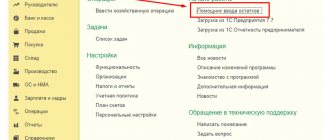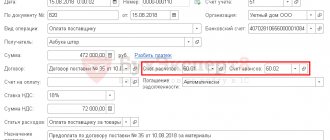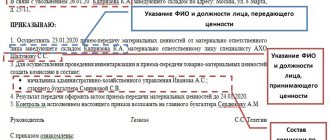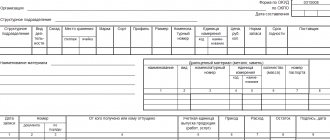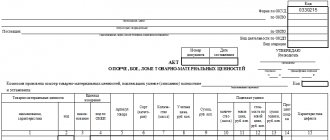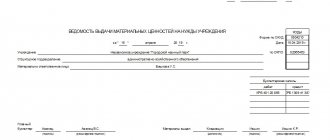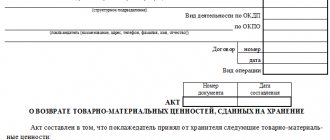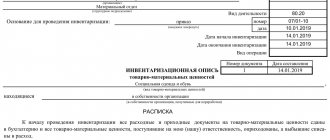Account 16 “Deviation in the cost of material assets” is used by organizations that reflect the cost of inventories at accounting prices. Accounting for acquired inventories is carried out using account 15 “Procurement and acquisition of material assets”.
Account 16 takes into account the difference (deviation) between the book price and the actual cost of inventories.
Account 16 “Deviation in the cost of material assets”
If the accounting price of inventories exceeds their actual cost, an entry is made for the amount of the excess:
Debit 15 Credit 16 – the excess of the book price of inventories over their actual cost is written off (savings).
If the accounting price of inventories is less than their actual cost, make the following entry:
Debit 16 Credit 15 – the excess of the actual cost of inventories over their book price (overexpenditure) is written off.
The debit balance of account 16 is written off at the end of the reporting month to those accounts to which consumed or sold inventories were written off, in proportion to the cost of inventories released into production or sold to customers.
The amount of deviations to be written off is calculated using the formula:
| Debit balance of account 16 at the beginning of the month + Turnover of debit of account 16 for the month | : | Balance on the debit of account 10 (41) at the beginning of the month + Turnover on the debit of account 10 (41) for the month | X | Turnover on credit account 10 (41) per month | = | Sum of deviations |
Deviations in the cost of materials released into production are written off to cost accounts (sales expenses):
Debit 20 (23, 25, 26, 44, ...) Credit 16 – the deviation in the cost of materials is written off.
The deviation in the cost of materials sold is written off to subaccount 91-2 “Other expenses”:
Debit 91-2 Credit 16 - the deviation in the cost of materials sold is written off.
The deviation for goods sold is written off to subaccount 90-2 “Cost of sales”:
Debit 90-2 Credit 16 - the deviation in the cost of goods sold is written off.
The credit balance on account 16 is reversed at the end of the reporting month in correspondence with those accounts to which inventories were written off, in proportion to the cost of inventories released into production or sold to customers.
Calculate the amount of deviations to be written off using the formula:
| Credit balance on account 16 at the beginning of the month + Turnover on credit account 16 for the month | : | Balance on the debit of account 10 (41) at the beginning of the month + Turnover on the debit of account 10 (41) for the month | X | Turnover on credit account 10 (41) per month | = | Sum of deviations |
The write-off of deviations for materials released into production is reflected by the entry:
Debit 20 (23, 25, 26, 44, ...) Credit 16 – the deviation in the cost of materials is reversed.
The deviation in the cost of materials sold is written off to subaccount 91-2 “Other expenses”:
Debit 91-2 Credit 16 - the deviation in the cost of materials sold is written off.
Deviations for goods sold, reflected at accounting (planned) prices, are written off to account 90-2 “Cost of sales”:
Debit 90-2 Credit 16 – the deviation in the cost of goods sold is reversed.
Methods for writing off deviations
Any enterprise has the opportunity to choose a method that allows you to write off the difference in prices for goods. Subsequently, the chosen method is prescribed in the accounting policy. The following options are currently available:
- leveling the difference in the circulation process - the technique is used when the discrepancy is no more than 10% of the valuation of goods;
- write-off at the beginning of the month by specific gravity is not the most accurate method + the deviation cannot be more than 5%;
- full write-off of the difference monthly based on value (the difference is no more than 5%).
The accountant chooses the methodology, subsequently coordinating it with management. Based on this, the accounting policy of the enterprise is formed.
Instructions 16 count
Instructions for using the chart of accounts for accounting the financial and economic activities of organizations in accordance with Order No. 94n dated October 31, 2000:
Account 16 “Deviation in the cost of material assets” is intended to summarize information about differences in the cost of acquired inventories, calculated in the actual cost of acquisition (procurement) and accounting prices, as well as data characterizing the amount of differences.
The amount of the difference in the cost of acquired inventories, calculated in the actual cost of acquisition (procurement) and accounting prices, is debited or credited to account 16 “Deviation in the cost of material assets” from account 15 “Procurement and acquisition of material assets.”
The differences in the cost of acquired inventories, calculated in the actual cost of acquisition (procurement), and accounting prices accumulated on account 16 “Deviation in the cost of material assets” are written off (reversed - if the difference is negative) to the debit of the production cost accounts (expenses for sale) or other relevant accounts.
Analytical accounting for account 16 “Deviation in the cost of material assets” is carried out for groups of inventories with approximately the same level of these deviations.
Key transactions and business transactions
If we consider the basic transactions within account 16, they look like this.
- Dt 16 Kt 15 - a reflection of the fact of deviation between the cost of materials and the actual cost.
- Dt 16 Kt 15 - a reflection of the deviation in the cost of materials.
- Dt 15 Kt 16 - reflects the fact of deviation between the cost indicator of materials and the actual cost parameter.
- Dt 20 Kt 16 - direct accrual of deviations occurred.
Typical postings for account 16
By debit of the account
| Contents of a business transaction | Debit | Credit |
| The amount of deviations of the actual cost of received inventories from accounting prices is taken into account (savings) | 16 | 15 |
| The amount of deviations in the cost of inventories received from the head office is taken into account (in the branch’s accounting) | 16 | 79-1 |
| The amount of deviations in the cost of inventories received from the branch allocated to a separate balance sheet (in the accounting of the head office) is taken into account. | 16 | 79-1 |
| The amount of deviations in the cost of inventories received as a contribution under a joint activity agreement is taken into account (on a separate balance sheet of the joint activity) | 16 | 80 |
By account credit
| Contents of a business transaction | Debit | Credit |
| Deviations in the value of inventories used in long-term investments are taken into account as part of non-current assets, | 08 | 16 |
| The amount of deviations of the actual cost of capitalized inventories from accounting prices is taken into account | 15 | 16 |
| The amount of deviations in the cost of inventories transferred to the main production was written off | 20 | 16 |
| The amount of deviations in the cost of inventories transferred to auxiliary production was written off | 23 | 16 |
| The amount of deviations in the cost of inventories transferred for general production needs was written off | 25 | 16 |
| The amount of deviations in the cost of inventories transferred for general business needs is written off | 26 | 16 |
| The amount of deviations in the cost of inventories transferred to the needs of servicing production was written off | 29 | 16 |
| The amount of deviations in the cost of inventories spent for trading activities was written off | 44 | 16 |
| The amount of deviations in the cost of inventories transferred to a branch allocated to a separate balance sheet was written off (posting in the accounting of the head office) | 79-1 | 16 |
| The amount of deviations in the cost of inventories transferred to the head office of the organization is written off (posting in the branch accounting) | 79-1 | 16 |
| The amount of deviations in the value of inventories transferred to the participant of a simple partnership upon termination of the agreement on joint activity was written off (on a separate balance sheet of the joint activity) | 80 | 16 |
| The amount of deviations in the value of inventories disposed of as a result of sale or write-off is taken into account as part of other expenses | 91-2 | 16 |
| The amount of deviations in the cost of inventories written off as a result of emergency circumstances is taken into account as part of the organization’s other expenses | 91-2 | 16 |
| The amount of deviations related to missing or damaged inventories was written off | 94 | 16 |
| The amount of deviations in the cost of inventories spent in performing work has been written off, the costs of which are taken into account as deferred expenses | 97 | 16 |
Regulatory framework
Accounting for material and production values is carried out on the basis of various documents. For ease of understanding, they are divided into several levels.
- First level. Legislative acts, administrative documents and decrees adopted by the President.
- Second level. Generally accepted accounting standards for record keeping.
- Third level. Various methodological recommendations.
- Fourth level. Documents adopted within the enterprise itself.
Thus, account 16 plays an important role in accounting and is used in reflecting a large number of transactions.
Section I. Non-current assets
Fixed assets 01 By types of fixed assets Depreciation of fixed assets 02 Profitable investments in tangible assets 03 By types of tangible assets Intangible assets 04 By types of intangible assets andon expenses for research, development and technological work
(name of the subaccount as amended, put into effect starting from the financial statements for 2003 by order of the Ministry of Finance of Russia dated May 7, 2003 No. 38n - see the previous edition) Amortization of intangible assets 05 ………………………………… …….. 06 Equipment for installation 07 Investments in non-current assets 08 1. Acquisition of land plots 2. Acquisition of environmental management facilities 3. Construction of fixed assets 4. Acquisition of fixed assets 5. Acquisition of intangible assets 6. Transfer of young animals to the main herd 7 . Acquisition of adult animals 8. Carrying out research,development and technological work
(the sub-account was additionally included starting from the financial statements for 2003 by order of the Ministry of Finance of Russia dated May 7, 2003 No. 38n) Deferred tax assets 09 (position as amended starting from the financial statements for 2003 by order of the Ministry of Finance of Russia dated May 7, 2003 No. 38n , - see previous edition)Section V. Cash
Cash desk 50 1. Cash desk of the organization 2. Operating cash desk 3. Cash documents Current accounts 51 Currency accounts 52 ……………………………………………………….. 53 ……………………………… ……….. 54 Special accounts in banks 55 1. Letters of credit 2. Check books 3. Deposit accounts ……………………………………………………….. 56 Transfers in transit 57 Financial investments 58 1. Shares and shares 2. Debt securities 3. Loans provided 4. Deposits under a simple partnership agreement Reserves for impairment of financial investments 59 (position as amended starting from the financial statements for 2003 by order of the Ministry of Finance of Russia dated May 7, 2003 No. 38n, - see previous edition)Section VI. Calculations
Settlements with suppliers and contractors 60 …………………………………….. 61 Settlements with buyers and customers 62 Provisions for doubtful debts 63 ………………………………………………………… .. 64 ……………………………………………………….. 65 Calculations for short-term credits and borrowings 66 By type of credits and loans Calculations for long-term credits and borrowings 67 By type of credits and loans Calculations for taxes and fees 68 By type of taxes and fees Settlements for social insurance and security 69 1. Settlements for social insurance 2. Settlements for pensions 3. Settlements for compulsory health insurance Settlements with personnel for wages 70 Settlements with accountable persons 71 ……………… ……………………….. 72 Settlements with personnel for other operations 73 1. Settlements for loans provided 2. Settlements for compensation for material damage ……………………………………………………….. 74 Settlements with founders 75 1. Settlements for contributions to the authorized (share) capital 2. Settlements for the payment of income Settlements with various debtors and creditors 76 1. Settlements for property and personal insurance 2. Settlements for claims 3. Settlements for due dividends and other income 4. Calculations for deposited amounts Deferred tax liabilities 77 (position as amended, put into effect starting from the financial statements for 2003 by order of the Ministry of Finance of Russia dated May 7, 2003 No. 38n - see the previous edition)……………………… ……………….. 78 On-farm settlements 79 1. Settlements for allocated property 2. Settlements for current operations 3. Settlements under a property trust management agreementSection VII. Capital
Authorized capital 80 Own shares (shares) 81 Reserve capital 82 Additional capital 83 Retained earnings (uncovered loss) 84 ……………………………………………………….. 85 Targeted financing 86 By type of financing ………… …………………………….. 87 ……………………………………………………….. 88 ……………………………………………………….. 89Section IV. Finished products and goods
Output of products (works, services) 40 Goods 41 1. Goods in warehouses 2. Goods in retail trade 3. Containers under goods and empty 4. Purchased items Trade margin 42 Finished goods 43 Selling expenses 44 Goods shipped 45 Completed stages of work in progress 46 ……………………………………………………….. 47 ……………………………………………………….. 48 …………………………………… …….. 49Characteristics of accounts 15, 16 and their features
Account 15 is active-passive, but in its economic essence it has all the signs of an active account, since it reflects information about the material assets of the enterprise. The actual value of the MC is accumulated on the account. Then, in correspondence with the account. 16 the differences between actual and accounting prices are revealed. The debit balance of the account reflects inventory items in transit that belong to the enterprise, but have not yet arrived at the warehouse.
Count 16 is active-passive, similar to count. 15, showing signs of being active. Reflects the deviation of the actual cost from the planned cost, recorded on accounts 10, 41, 07.


